

Finding the Next Earth. A New Study Challenges Assumptions About the Origins of Earth's Water. Where In Our Galaxy Are All The Aliens? Here's How Planet Hunters Are Going to Find the Next Earth. The Most Extreme Environments Where Alien Life Could Be Found. A New Mantra, 'Follow the Methane,' May Advance Search For Alien Life. Kepler-22b. Complex Organic Molecules Discovered in Infant Star System. Eso1513 — Science Release Hints that the building blocks of the chemistry of life are universal 8 April 2015 For the first time, astronomers have detected the presence of complex organic molecules, the building blocks of life, in a protoplanetary disc surrounding a young star.
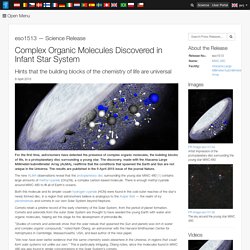
NASA to Expand its Search for Earth-like Planets. Two Billion Reasons Why We're About to Find Earth 2. The silence out there has me worried that advanced species are very rare or...maybe...we're it.

Statistically, if advanced intelligence were common, there should be millions of space faring species out there. We're only 100 years into being capable of transmitting interstellar signals: if other civilizations were only 500 years more advanced, think what they could do (BTW- we might actually be at that point were it not for the Dark Ages). 500 years is nothing though. What if they had a 1 million year head start on us: you'd think they'd have at minimum probes reaching around the galaxy by now. New Kepler data could change our odds of meeting aliens. Hmmm...

Well, when you don't include the probability of multiple planets in a habitable region of a Giant star or something other than Dwarf or Suwarf stars, thew odds are going to be a bit skewed against intelligent life. Plus there are Brown Dwarfs and Super Jupiters just ouside of habitable zones of many stars, that could easily provide enough heat to allow one or more of their moons to support intelligent life. Galaxy is CRAMMED with HABITABLE PLANETS – and probably ALIENS. Fresh data from the Kepler space telescope shows at least a fifth of stars surveyed have Earth-like planets in a "Goldilocks" orbit – a habitable sweet spot that's not too hot or too cold for liquid water – and that's just the stars we can see.
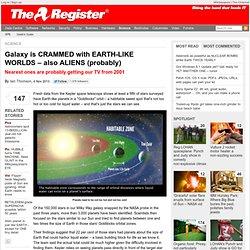
Planets need to be not too hot and not too cold Of the 150,000 stars in our Milky Way galaxy snapped by the NASA probe in the past three years, more than 3,000 planets have been identified. Scientists then focused on the stars similar to our Sun and tried to find planets between one and two times the size of Earth in those stars' Goldilocks orbital zones. Further evidence that there are many habitable planets for humans to colonize. Searching for life in our galaxy may have just gotten a little harder. If ozone is being created, then it's probably only present in the higher atmosphere, above the mixing, weather-bearing levels.
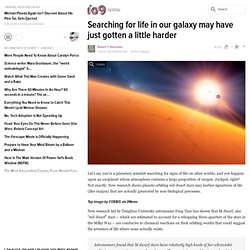
Further, ozone is known to block ultraviolet radiation, which would limit the mechanism's action in lower levels. An atmosphere may show a strong signature, but a higher resolution detection method would need to be created in order to tell whether the lower atmosphere contains the same concentration (looking through the atmosphere at the limb rather than the average reflected starlight we can get now). There's a chance, though, that if the planet is tidally-locked (as may be likely), the subsolar heating would be strong enough to form a full-depth convective structure in the atmosphere, mixing it thoroughly. The downside is that it would be full of ozone, which is highly destructive to plastics and metals, not to mention being dangerous to air-breathing Earthlings.
Exactly. Why scientists need to search for alien life on purple planets. Habitable moons beyond our solar system? Astronomers say it's possible. Super-Earth Gliese 1214b Has Water-Rich Atmosphere, Japanese Astronomers Say. Astronomers from Japan using NAOJ’s Subaru Telescope have found that the extrasolar planet Gliese 1214b has a water-rich atmosphere.
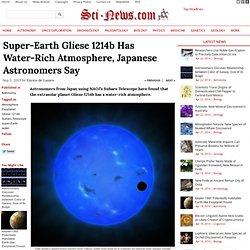
This artist’s impression shows how Gliese 1214b may look as it transits its parent star. Image credit: NAOJ. Discovered in 2009 by the MEarth Project, this alien world is about 2.7 times Earth’s diameter and is almost 7 times as massive. It is located 42 light years away in the constellation Ophiuchus. Dr Michitoshi Yoshida of Hiroshima University and his colleagues used the Suprime-Cam and the FOCAS optical camera aboard the Subaru Telescope to look for the Rayleigh scattering feature in the atmosphere of Gliese 1214b. The new observations, reported in the Astrophysical Journal (arXiv.org), showed that the exoplanet’s atmosphere does not display strong Rayleigh scattering. Red Dwarfs Could Host 60 billion Habitable Planets in the Milky Way. Planets can form and survive in insanely dense star clusters.
I suspect that any big, short-lived stars blew their tops long ago.
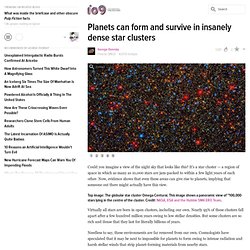
The smaller stars will last for billions of years before blowing, so there should be a nice long window of opportunity. I wish I could agree with Artor, but it's vastly oversimplifying to say "any big, short-lived stars blew their tops long ago," for a number of reasons. Firstly, a large percentage of supernovas result from binary systems in which a white dwarf "steals" mass from it's binary partner until it reaches a critical point and explodes.
Supernovae are not limited to enormous, short-lived stars. In a cluster you will find supergiants and dwarfs and everything between. Astronomers confirm there are two potentially habitable planets orbiting Gilese 581.